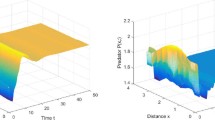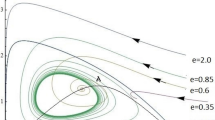Abstract
This work is concerned with the fast–slow dynamics for intraguild predation models with evolutionary effects. Assuming the survival pressure of the weaker predator induces evolution of it to the intraguild predator, then the system can be viewed as a singularly perturbed problem with two different time scales—predation time scale and evolution time scale. Using the geometric singular perturbation theory, we first completely analyze the limiting slow–fast dynamics of the system which involve the existence of turning points. Then, an application of the geometric singular perturbation theory gives rise to the birth of relaxation oscillations caused by the turning points and the associated delay of stability loss. From our main results, one can see that evolution enhances survival rates of inferior competitors.














Similar content being viewed by others
References
Abrams, P.A., Matsuda, H., Harada, Y.: Evolutionarily unstable fitness maxima and stable fitness minima of continuous traits. Evol. Ecol. 7, 465–487 (1993)
Armstrong, R.A., McGehee, R.: Competitive exclusion. Am. Nat. 115(2), 151–170 (1980)
Ermentrout, B.: Simulating, Analyzing, and Animating Dynamical Systems: A Guide to XPPAUT for Researchers and Students, vol. 14. SIAM, Philadelphia (2002)
Fenichel, N.: Persistence and smoothness of invariant manifolds and flows. Indiana Univ. Math. J. 21, 193–226 (1971)
Fenichel, N.: Geometric singular perturbation theory for ordinary differential equations. J. Differ. Equ. 31, 53–98 (1979)
Hardin, G.: The competitive exclusion principle. Science 131, 1292–1297 (1960)
Hong, J.M., Hsu, C.-H., Huang, B.-C., Yang, T.-S.: Geometric singular perturbation approach to the existence and instability of stationary waves for viscous traffic flow models. Commun. Pure Appl. Anal. 12, 1501–1526 (2013)
Hong, J.M., Hsu, C.-H., Liu, W.: Viscous standing asymptotic states of isentropic compressible flows through a nozzle. Arch. Ration. Mech. Anal. 196, 575–597 (2010)
Hong, J.M., Hsu, C.-H., Liu, W.: Viscous standing asymptotic states of transonic flow through a nozzle of varying area. J. Differ. Equ. 248, 50–76 (2010)
Hek, G.: Geometric singular perturbation theory in biological practice. J. Math. Biol. 60, 347–386 (2010)
Holt, R.D., Polis, G.A.: A theoretical framework for intraguild predation. Am. Nat. 149, 745–764 (1997)
Hsu, C.-H., Yang, C.-R., Yang, T.-H.: Diversity of traveling waves in FitzHugh–Nagumo type equations. J. Differ. Equ. 247, 1185–1205 (2009)
Hsu, S.-B., Ruan, S., Yang, T.-H.: Analysis of three species Lotka–Volterra food web models with omnivory. J. Math. Anal. Applv 426, 659–687 (2015)
Jones, C.K.R.T., Kopell, N.: Tracking invariant manifolds with differential forms in singularly perturbed systems. J. Differ. Equ. 108, 64–88 (1994)
Jones, C.K.R.T.: Geometric singular perturbation theory. In: Dold, A., Takens, F. (eds.) Dynamical Systems (MontecatiniTerme, 1994). Lecture Notes in Mathematics, vol. 1609, pp. 44–118. Springer, Berlin (1995)
Jones, C.K.R.T., Kaper, T.J., Kopell, N.: Tracking invariant manifolds up to exponentially small errors. SIAM J. Math. Anal. 27, 558–577 (1996)
Koch, A.L.: Competitive coexistence of two predators utilizing the same prey under constant environmental conditions. J. Theor. Biol. 44, 373–386 (1974)
Krupa, M., Szmolyan, P.: Extending geometric singular perturbation theory to nonhyperbolic points-fold and canard points in two dimensions. SIAM J. Math. Anal. 33, 286–314 (2001)
Kuznetsov, Y.A.: Elements of Applied Bifurcation Theory. Springer, New York (1995)
Li, M.Y., Liu, W., Shan, C., Yi, Y.: Turning points and relaxation oscillation cycles in simple epidemic models. SIAM J. Appl. Math. 76(2), 663–687 (2016)
Lin, X.-B., Schecter, S.: Stability of self-similar solutions of the Dafermos regularization of a system of conservation laws. SIAM J. Math. Anal. 35, 884–921 (2004)
Liu, W.: Exchange lemmas for singular perturbation problems with certain turning points. J. Differ. Equ. 167, 134–180 (2000)
Liu, W.: Multiple viscous wave fan profiles for Riemann solutions of hyperbolic systems of conservation laws. Discrete Contin. Dyn. Syst. A 10, 871–884 (2004)
Liu, W.: Geometric singular perturbation approach to steady-state Poisson–Nernst–Planck systems. SIAM J. Appl. Math. 65, 754–766 (2005)
Liu, W.: One-dimensional steady-state Poisson–Nernst–Planck systems for ion channels with multiple ion species. J. Differ. Equ. 246, 428–451 (2009)
Liu, W., Wang, B.: Poisson–Nernst–Planck systems for narrow tubular-like membrane channels. J. Dyn. Differ. Equv 22, 413–437 (2010)
Liu, W., Xiao, D., Yi, Y.: Relaxation oscillations in a class of predator-prey systems. J. Differ. Equ. 188, 306–331 (2003)
Liu, W., Xu, H.: A complete analysis of a classical Poisson–Nernst–Planck model for ionic flow. J. Differ. Equ. 258, 1192–1228 (2015)
De Maesschalck, P., Schecter, S.: The entryexit function and geometric singular perturbation theory. J. Differ. Equ. 260, 6697–6715 (2016)
McGehee, R., Armstrong, R.A.: Some mathematical problems concerning the ecological principle of competitive exclusion. J. Differ. Equ. 23(1), 30–52 (1977)
Piltz, S.H., Veerman, F., Maini, P.K., Porter, M.A.: A predator-2 prey fast–slow dynamical system for rapid predator evolution. SIAM J. Appl. Dyn. Syst. 16, 54–90 (2017)
Polis, G.A., Myers, C.A., Holt, R.D.: The ecology and evolution of intraguild predation-potential competitors that eat each other. Ann. Rev. Ecol. Syst. 20, 297–330 (1989)
Prokin, I., Park, Y.: https://github.com/iprokin/Py_XPPCALL (2017). Accessed 26 Sep 2017
Schecter, S.: Undercompressive shock waves and the Dafermos regularization. Nonlinearity 15, 1361–1377 (2002)
Schecter, S.: Eigenvalues of self-similar solutions of the Dafermos regularization of a system of conservation laws via geometric singular perturbation theory. J. Dyn. Differ. Equ. 18, 53–101 (2006)
Schecter, S., Szmolyan, P.: Composite waves in the Dafermos regularization. J. Dyn. Differ. Equ. 16, 847–867 (2004)
Shen, J.: Canard limit cycles and global dynamics in a singularly perturbed predator-prey system with non-monotonic functional response. Nonlinear Anal. Real World Appl. 31, 146–165 (2016)
Szmolyan, P., Wechselberger, M.: Canards in \(\mathbb{R}^3\). J. Differ. Equ. 177, 419–453 (2001)
Wang, C., Zhang, X.: Stability loss delay and smoothness of the return map in slow–fast systems. SIAM J. Appl. Dyn. Syst. 17(1), 788–822 (2018)
Acknowledgements
The authors would like to thank the anonymous referee’s valuable comments and suggestions which have led to an improvement of the presentation.
Author information
Authors and Affiliations
Corresponding author
Additional information
Publisher's Note
Springer Nature remains neutral with regard to jurisdictional claims in published maps and institutional affiliations.
Jianhe Shen: This author was partially supported by the National Natural Science Foundation of China (Grant No. 11771082). Cheng-Hsiung Hsu:This author was partially supported by the MOST (Grant No. 107-2115-M-008-009-MY3) and NCTS of Taiwan. Ting-Hui Yang: This author was partially supported by the MOST (Grant No. 106-2115-M-032 -003-MY2) and NCTS of Taiwan.
Rights and permissions
About this article
Cite this article
Shen, J., Hsu, CH. & Yang, TH. Fast–Slow Dynamics for Intraguild Predation Models with Evolutionary Effects. J Dyn Diff Equat 32, 895–920 (2020). https://doi.org/10.1007/s10884-019-09744-3
Received:
Published:
Issue Date:
DOI: https://doi.org/10.1007/s10884-019-09744-3
Keywords
- Intraguild predator
- Geometric singular perturbation theory
- Turning points
- Delay of stability loss
- Relaxation oscillation
- Transcritical bifurcation
- Delayed bifurcation




